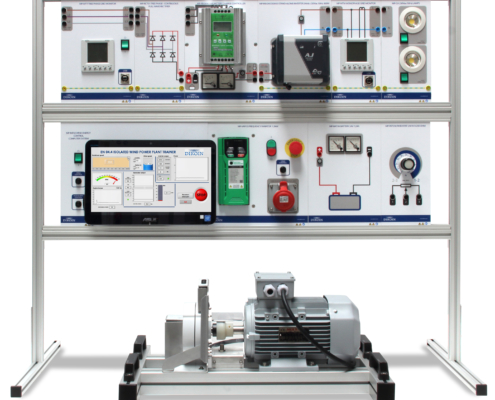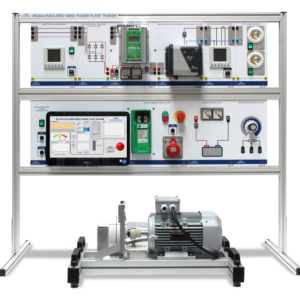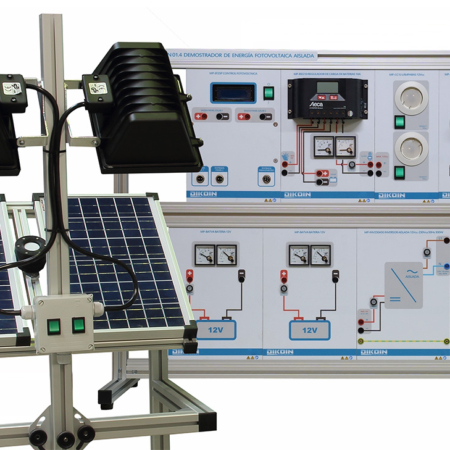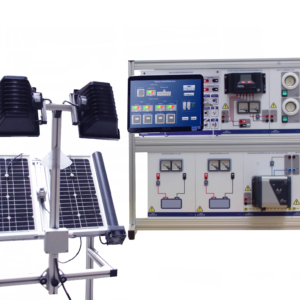EN 04.4 – Stand-Alone Wind Power Plant Trainer
With the EN 04.4 equipment, we emulated the behavior of a wind turbine in a practical and didactic way. An electric motor acts as the blades and bush of a wind turbine, dragging a three-phase synchronous generator of permanent magnets, which transforms the mechanical energy transmitted to the shaft into electrical energy at the output.
The current generated is alternating three-phase, having to transform into direct current to be able to feed the regulator of charge of batteries and consumptions, and later to the inverter that in turn turns this into alternating current with the appropriate frequency. So that the generated electric energy can be stored in batteries or consumed directly, or also use the stored charge for consumption when is no wind.
The equipment is designed to understood in a very visual and intuitive way quickly the operation of the assembly, not only knowing the elements of which it consists, but having them also to connect by means of the security cables supplied for that purpose. This is achieved by arranging the equipment in schematic and connectable panels.
In addition it counts on a computer from which we control the operation of the equipment and we obtain the reading of all the necessary variables for the analysis of the system.
- Study of the operation and disposal of an isolated wind power generation system.
- Drawing of the characteristic curves of the generator:
- Three-phase voltage depending on the speed of rotation.
- DC voltage depending on the speed of rotation.
- Torque based on the generated current.
- Three-phase active power depending on the speed of rotation.
- DC Power as a function of the speed of rotation.
- Three-phase reactive power as a function of the speed of rotation.
- Calculation of the constant of torque / current and voltage / speed of rotation of the generator.
- Performance of the rectifier.
- Tracing of yield calculation curves: Electric power to the net / mechanical drag power.
- Determination of optimum operating points against variable atmospheric conditions.
- Tracing of the power-wind speed characteristic curve.
- Structure of anodised aluminum.
- Single-phase network analyzer with indication of active, reactive and apparent power, current, voltage, frequency, power factor, etc.
- Three-phase network analyzer with indication of active, reactive and apparent power, current, voltage, frequency, power factor, etc.
- Analog DC voltage and current indicators for 12V batteries and loads.
- Three-phase synchronous generator of permanent magnets.
- Battery Charge Controller: Regulator with operation 12 or 24V DC, and maximum current = 10A. Maximum input voltage = 45V.
- Batery of 12V 12Ah.
- Three phase full wave rectifier.
- Variable consumption rheostat.
- 2 AC lamps.
- 1.5 kW asynnchronous motor.
- 200VA 230V / 50Hz inverter.
- Frecuency variator 1,5 kW.
- Data acquisition module.
- Computer with control and data acquisition software.
- The equipment is supplied with a complete experiments manual.
- Input: 230V/50Hz.
- Note: The picture shown may not correspond exactly to the supplied equipment.









